LT1 GDI owners
#421
Team Owner


Member Since: Oct 2013
Location: Kansas City, Missouri
Posts: 25,360
Received 7,752 Likes
on
4,181 Posts
CORVETTE TODAY Host
St. Jude Donor'15

Ttttt
#422
Have several threads on the intake valve coking issues with the LT4, so will make this one for the LT1.
This video does a good job of showing you what the issues are, the causes, and better understanding your new generation engine and how to prevent issues down the road. Look close and pause the video several times to see just how rapidly the intake valves are building the deposits.
https://www.youtube.com/watch?v=7Pz0zTQ1bz0
I recommend the crushed walnut shell blasting media service but the manual cleaning as shown will also work.
Now, much of this is redundant if a member searches, but I will cover it all here for the C7 crowd in one thread.
Prior to 2014, all GM V8 gasoline engines were port injection. This constantly showered the intake valves with detergent fuel (ALL gasoline in the US must have minimum mandated detergent content to keep valves clean from back prior to port injection when carbureted engines experienced this coking causing wear to valve guides and stems resulting in a needed valve job by 40-50k miles) and when the industry migrated to the port fuel injection most have grown up with valve jobs went the way of the dinosaur, that is until GDI came onto the scene to be able to meet Federal emissions and CAFE fuel economy standards. So, here is a diagram of how a port injection fuel system kept your intake valves spotless longer than the life of the engine, and why most do not remember when a valve job was part of owning a car:
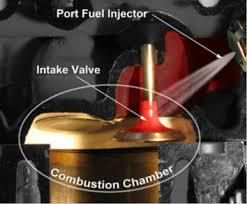
This fuel spray kept the valves cool and clean and even after 100-200k miles, a port injection engines intake valves will never have deposits on then, and therefore the valve guides and stems rarely saw wear (unless a machining error as the LS7 is known for in some instances) and the main reason for a "catchcan" was to stop the oil ingestion that caused detonation, clogged ringlands, and other issues, but never contributed to premature wear of internal engine parts and the degradation of power and economy over time like we see today with GDI.
Below shows how now, top tier fuel does nothing to improve any part of the injection or fuel system, and the fuel never touches the valves:
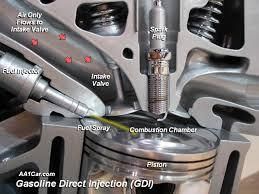
There are many advantages to GDI vs PFI, and this is mainly due to the near elimination of detonation (pre-ignition, Knock, etc.) as the fuel no longer is present through the entire intake and compression stroke where any glowing carbon spec or hot point in the combustion chamber could pre-ignite the A/F mixture. Now the fuel is not introduced until the final 10% or so of the compression stroke, and it is present only milliseconds (most of the combustion process occurs before the fuel can even touch the piston top) so we can now see far higher compression ratios, lower octane fuels, less emissions, and better fuel economy. The fuel injectors now operate at 2000 plus PSI vs the 45-55 of old PFI, so they cannot easily form ANY deposits. This renders any fuel additives, top tier fuels, etc. useless and a waste where they were of great benefit to the PFI engine.
The downside is with no fuel to keep the valves cool and deposits free, we now have a far greater issue that back in the 60's and 70's when carbureted engines had the coking and wear issues from it. AT least then some fuel cooled and cleaned/slowed deposits. Now there is zero.
So, a valve that would have looked like these pictures of a PFI engine at say 142000 miles (actual mileage of the LS engine in these pictures):

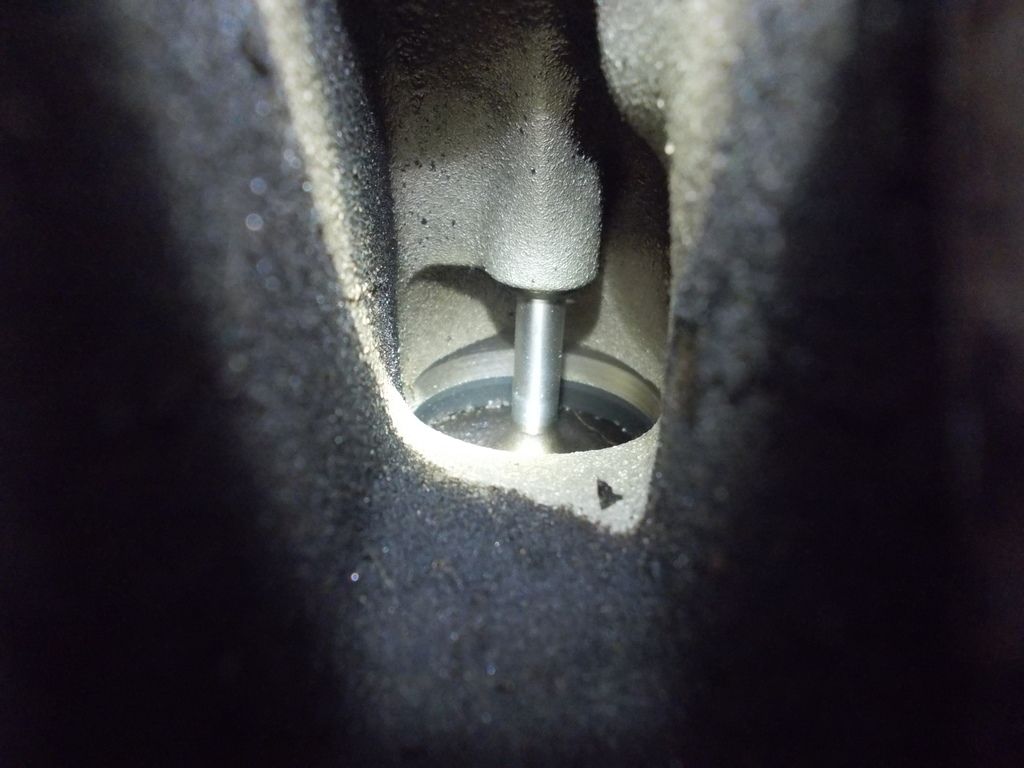

now will look like this in as little as 40k miles:
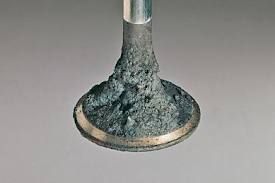
And the deposits are not like the soft carbon build up on piston tops of PFI, these are hard crystallized very abrasive deposits that are pulled into the guide with every cycle of the intake valve causing premature wear far greater that back in the carbureted days. Look close at how the stem suffers as these deposits wear on it, and the guide is the softer of the material:

These deposits are caused by more than just the oil mist present in the intake air charge, there is also several other damaging compounds that enter the crankcase as blow-by, and what you see is only part of the issue. Over time, as these hard abrasive pieces break loose, smaller ones can be forced between the piston and cylinder wall causing scouring and larger ones can get trapped between the valve and seat causing piston to valve contact and a bent valve or worse:
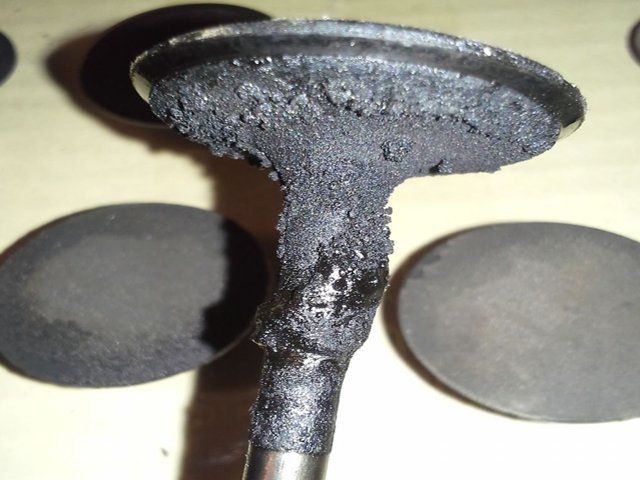
Look closely at the valve above, and you can see on the left portion of the stem where the tulip meets a large chunk broke off and caused the damage. The owner bringing the car in to the dealer they did diagnose it right away so a good amount of driving was done after this occurred and you can see the additional build-up over where the chunk broke off.
Now, anyone with a 2014 or 2015 LT1 have doubts this is occurring in your engine? It only takes 5-10 minutes and minimal tools to remove your intake manifold and look at YOUR valves up close and see the severity at the miles you have on yours.
Now, how to prevent this?
The "catchcans" of the past that worked well with a PFI engine, only trapped 15-50% or so of this oil mix that bakes onto the valves so they may slightly slow the coking, but will do little to stop it. You must use one of the very few that catch and trap 95-08% of this mix, and those are true air/oil separation devices. ColoradoSpeed and Elite Engineering having two of the most effective period currently on the market (extensive test results available to any that wish to see how the other "catchcans" stack up).
You must stop as much of this as possible.
Now, looking around I see several well intended solutions, that are not well thought out, and the most common is to delete the PCV system, and just rout your clean and dirty side lines into a tank with breather, or worse, open hoses near the ground (where one due to the Venturi effect will suck up dust and dirt directly into the tank and the engine).
The PCV system does far more than satisfy emissions. Back when the Fed mandated the PCV system in the mid 60's, it was rare for an engine to go much over 50k miles before excessive wear of all internal parts resulted in an entire rebuild being needed. And even though the PCV system was mandated for emissions alone (before that draft tubes were the norm, similar to the breathered Tanks seen today) but it did not take long for the industry to see these same engines were going 100-150k plus miles with little internal wear. Studying this found that the PCV system was constantly removing the damaging combustion by-products from the crankcase as soon as they entered and were still in a gaseous state. If allowed to settle, these mixed with the oil contaminating it and causing wear and failure eventually. The PCV system was removing these allowing the oil to stay cleaner longer, and the damaging compounds to accumulate at a minimal amount. So, defeating your PCV system is a sure way to cause a shortened engine life and accelerated wear. The compounds causing this wear and damage are as follows:
Water vapor
Unburnt fuel
Abrasive soot and carbon particles
Sulfuric acid, and more.
70% plus of internal engine wear is caused by the particles in the 2-5 micron size, and as your oil filter can only trap down to 15 microns in size, if these are allowed to accumulate in the engine oil and crankcase, you are drastically shortening the life of your engine. ANY defeat of any critical function of your PCV system is going to allow this, and/or worse. Allowing pressure to build and vent is also damaging over time to the rings, ringlands, and cylinder walls due to "ring flutter" and other damage caused by ring instability, so you want to pull vacuum/suction at all times, and NOT ever vent pressure as it must first build until it can vent, and no good comes from crankcase pressure.
So, the systems that deal with this properly are addressing the dirty, or foul side with a truly effective separation device, and w special separator that is used on the "clean, or fresh side" and add a secondary evacuation suction source for when the engine is under acceleration and no intake manifold vacuum is present.
I'll stop here for now and invite questions and discussion on the GDI engines in general, and more specific GM's and what they have done to reduce the ingestion, and why this affects EVERY single GDI engine made in the World from every auto maker. Understanding and making the correct emissions compliant, not effecting warranty changes to ensure you get the longest enjoyable life out of these awesome engines.

This video does a good job of showing you what the issues are, the causes, and better understanding your new generation engine and how to prevent issues down the road. Look close and pause the video several times to see just how rapidly the intake valves are building the deposits.
https://www.youtube.com/watch?v=7Pz0zTQ1bz0
I recommend the crushed walnut shell blasting media service but the manual cleaning as shown will also work.
Now, much of this is redundant if a member searches, but I will cover it all here for the C7 crowd in one thread.
Prior to 2014, all GM V8 gasoline engines were port injection. This constantly showered the intake valves with detergent fuel (ALL gasoline in the US must have minimum mandated detergent content to keep valves clean from back prior to port injection when carbureted engines experienced this coking causing wear to valve guides and stems resulting in a needed valve job by 40-50k miles) and when the industry migrated to the port fuel injection most have grown up with valve jobs went the way of the dinosaur, that is until GDI came onto the scene to be able to meet Federal emissions and CAFE fuel economy standards. So, here is a diagram of how a port injection fuel system kept your intake valves spotless longer than the life of the engine, and why most do not remember when a valve job was part of owning a car:

This fuel spray kept the valves cool and clean and even after 100-200k miles, a port injection engines intake valves will never have deposits on then, and therefore the valve guides and stems rarely saw wear (unless a machining error as the LS7 is known for in some instances) and the main reason for a "catchcan" was to stop the oil ingestion that caused detonation, clogged ringlands, and other issues, but never contributed to premature wear of internal engine parts and the degradation of power and economy over time like we see today with GDI.
Below shows how now, top tier fuel does nothing to improve any part of the injection or fuel system, and the fuel never touches the valves:

There are many advantages to GDI vs PFI, and this is mainly due to the near elimination of detonation (pre-ignition, Knock, etc.) as the fuel no longer is present through the entire intake and compression stroke where any glowing carbon spec or hot point in the combustion chamber could pre-ignite the A/F mixture. Now the fuel is not introduced until the final 10% or so of the compression stroke, and it is present only milliseconds (most of the combustion process occurs before the fuel can even touch the piston top) so we can now see far higher compression ratios, lower octane fuels, less emissions, and better fuel economy. The fuel injectors now operate at 2000 plus PSI vs the 45-55 of old PFI, so they cannot easily form ANY deposits. This renders any fuel additives, top tier fuels, etc. useless and a waste where they were of great benefit to the PFI engine.
The downside is with no fuel to keep the valves cool and deposits free, we now have a far greater issue that back in the 60's and 70's when carbureted engines had the coking and wear issues from it. AT least then some fuel cooled and cleaned/slowed deposits. Now there is zero.
So, a valve that would have looked like these pictures of a PFI engine at say 142000 miles (actual mileage of the LS engine in these pictures):



now will look like this in as little as 40k miles:

And the deposits are not like the soft carbon build up on piston tops of PFI, these are hard crystallized very abrasive deposits that are pulled into the guide with every cycle of the intake valve causing premature wear far greater that back in the carbureted days. Look close at how the stem suffers as these deposits wear on it, and the guide is the softer of the material:

These deposits are caused by more than just the oil mist present in the intake air charge, there is also several other damaging compounds that enter the crankcase as blow-by, and what you see is only part of the issue. Over time, as these hard abrasive pieces break loose, smaller ones can be forced between the piston and cylinder wall causing scouring and larger ones can get trapped between the valve and seat causing piston to valve contact and a bent valve or worse:

Look closely at the valve above, and you can see on the left portion of the stem where the tulip meets a large chunk broke off and caused the damage. The owner bringing the car in to the dealer they did diagnose it right away so a good amount of driving was done after this occurred and you can see the additional build-up over where the chunk broke off.
Now, anyone with a 2014 or 2015 LT1 have doubts this is occurring in your engine? It only takes 5-10 minutes and minimal tools to remove your intake manifold and look at YOUR valves up close and see the severity at the miles you have on yours.
Now, how to prevent this?
The "catchcans" of the past that worked well with a PFI engine, only trapped 15-50% or so of this oil mix that bakes onto the valves so they may slightly slow the coking, but will do little to stop it. You must use one of the very few that catch and trap 95-08% of this mix, and those are true air/oil separation devices. ColoradoSpeed and Elite Engineering having two of the most effective period currently on the market (extensive test results available to any that wish to see how the other "catchcans" stack up).
You must stop as much of this as possible.
Now, looking around I see several well intended solutions, that are not well thought out, and the most common is to delete the PCV system, and just rout your clean and dirty side lines into a tank with breather, or worse, open hoses near the ground (where one due to the Venturi effect will suck up dust and dirt directly into the tank and the engine).
The PCV system does far more than satisfy emissions. Back when the Fed mandated the PCV system in the mid 60's, it was rare for an engine to go much over 50k miles before excessive wear of all internal parts resulted in an entire rebuild being needed. And even though the PCV system was mandated for emissions alone (before that draft tubes were the norm, similar to the breathered Tanks seen today) but it did not take long for the industry to see these same engines were going 100-150k plus miles with little internal wear. Studying this found that the PCV system was constantly removing the damaging combustion by-products from the crankcase as soon as they entered and were still in a gaseous state. If allowed to settle, these mixed with the oil contaminating it and causing wear and failure eventually. The PCV system was removing these allowing the oil to stay cleaner longer, and the damaging compounds to accumulate at a minimal amount. So, defeating your PCV system is a sure way to cause a shortened engine life and accelerated wear. The compounds causing this wear and damage are as follows:
Water vapor
Unburnt fuel
Abrasive soot and carbon particles
Sulfuric acid, and more.
70% plus of internal engine wear is caused by the particles in the 2-5 micron size, and as your oil filter can only trap down to 15 microns in size, if these are allowed to accumulate in the engine oil and crankcase, you are drastically shortening the life of your engine. ANY defeat of any critical function of your PCV system is going to allow this, and/or worse. Allowing pressure to build and vent is also damaging over time to the rings, ringlands, and cylinder walls due to "ring flutter" and other damage caused by ring instability, so you want to pull vacuum/suction at all times, and NOT ever vent pressure as it must first build until it can vent, and no good comes from crankcase pressure.
So, the systems that deal with this properly are addressing the dirty, or foul side with a truly effective separation device, and w special separator that is used on the "clean, or fresh side" and add a secondary evacuation suction source for when the engine is under acceleration and no intake manifold vacuum is present.
I'll stop here for now and invite questions and discussion on the GDI engines in general, and more specific GM's and what they have done to reduce the ingestion, and why this affects EVERY single GDI engine made in the World from every auto maker. Understanding and making the correct emissions compliant, not effecting warranty changes to ensure you get the longest enjoyable life out of these awesome engines.

Last edited by mbaessler; 06-28-2017 at 05:00 PM.
#423
I would assume the Base Corvette with a wet sump engine has the issue also. Is it as bad as the dry sump in the Z51's GS etc.?
#424
Drifting


So Car and Driver just finished a year long/40k mile test and saw no loss in performance when testing the car at 40k when new, same 0-60mph and same 1/4 time and mph. I'm curious on people's thoughts on this.
#426
Race Director


Member Since: May 2004
Location: Raleigh, NC
Posts: 16,664
Received 1,194 Likes
on
1,053 Posts
St. Jude Donor '15

It is a stainless steel mesh that vaporized liquid will attach to:
"An oil water separator, or OWS, contains coalescing media. This media provides a suitable surface for oil droplets to meet and grow, or coalesce, into larger droplets."
Or for more technical info:
http://www.coalescingconcepts.com/pr...dia-design.php
"An oil water separator, or OWS, contains coalescing media. This media provides a suitable surface for oil droplets to meet and grow, or coalesce, into larger droplets."
Or for more technical info:
http://www.coalescingconcepts.com/pr...dia-design.php
The first one I'm not really interested in, it's been beat to death already, but the second one I haven't seen much on. How much air can you move through the size hoses your cans use? Do they start becoming a restriction at 600hp, 700hp, 1000hp? Where's the limit?
#427
It would be nice to see the valve stems on a LT1 that has had a catch can attached for at least 10-20K miles or more to see how well the catch can is doing from stopping the coking or greatly reducing it. I'm test driving a vette today with the idea of purchasing this fall. This whole GDI and coking mess is giving me second thoughts.
#428
Melting Slicks


Thread Starter
Sounds like the engineers at GM have to mount a injector the sprays in the port in addition to the direct injector to spray the valve stems with fuel which will clean them.This is a poor design. The catch can will help but does not eliminate the problem. Great explanation and photos.
This was performed by a member here, that is an Aerospace Engineer and is very knowledgeable. This is what he found:
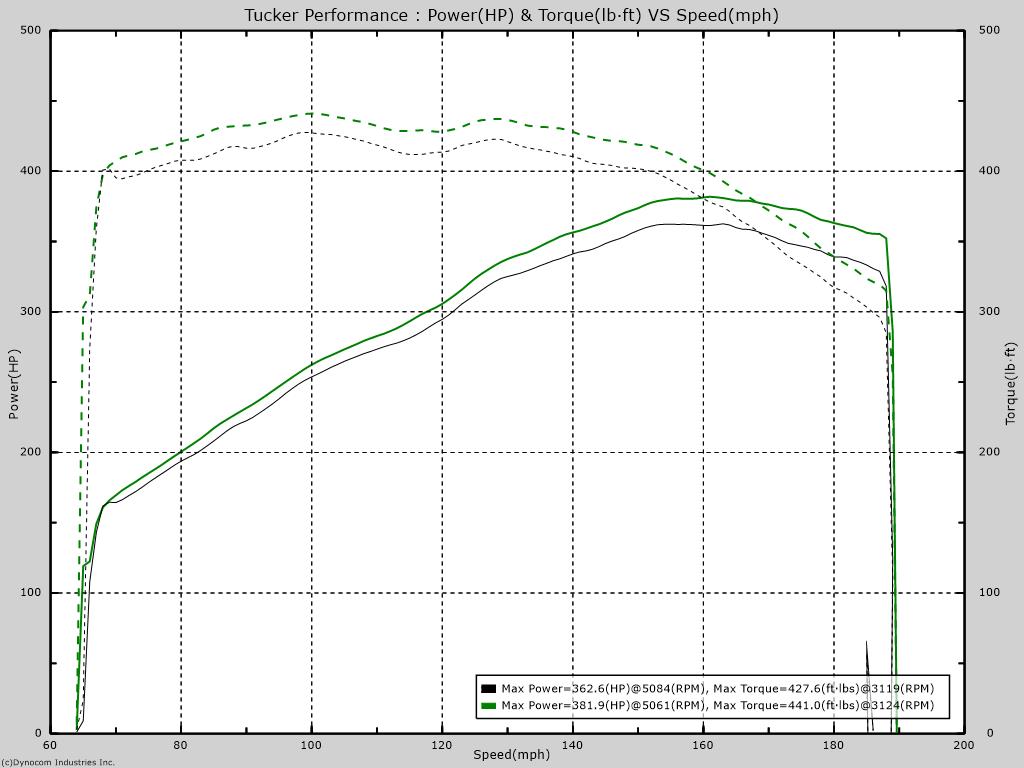
So I would ask Car & Driver to bring n one with 40k miles on it and do before and after dyno runs with a manual cleaning performed in between with as many that wish to witness this as want to. We have done dozens of different makes/models and have yet to see one without a pretty dramatic restoration of power after cleaning the coking deposits.
Correct.
To me there's two parts of this whole catch can debate. 1. Does it stop oil from getting into the intake. and 2. Can it flow enough under worst case conditions to not cause any pressure to build in the crankcase. Worst case meaning WOT w/boost, etc.
The first one I'm not really interested in, it's been beat to death already, but the second one I haven't seen much on. How much air can you move through the size hoses your cans use? Do they start becoming a restriction at 600hp, 700hp, 1000hp? Where's the limit?
The first one I'm not really interested in, it's been beat to death already, but the second one I haven't seen much on. How much air can you move through the size hoses your cans use? Do they start becoming a restriction at 600hp, 700hp, 1000hp? Where's the limit?
For turbo or Centrifugal systems, that pressurize the IM, anything over 8-10# of boost need the "Big Azz", or Elites E2-X Ultra. What happens if there is a piston/ring seal issue and crankcase pressure exceeds the systems ability to continue to pull sufficient evacuation suction? The cleanside separator allows any pressure to vent into the main air filter/intake assy. with the oil scrubbed from it and no flaps or valves to open, It does so immediately with no real flow restrictions, and instead of an oily smelly mess in the engine compartment, it is only scrubbed vapors and into the main air intake. So it retains a closed system as well as pulls actual suction on the crankcase at all times VS just at idle or deceleration as others. So there is no "weak" or "Down side" of these systems. You have your choice of -6, -8, or -10 lines and fittings to match the needs of your build, and there is even an unscrupulous competitor with a video up using a shop vac that plugs one outlet and uses only 1/2 of the system to attempt to show flow restrictions that are not present. The entire system is a package designed to address all points of ingestion and also provide the greatest unrestricted flow while being the most effective design on the market period. That is why the "catchcan Challenge" is offered. This is an example right here:
NO other can design comes close, and we make this claim and challenge in public.
It would be nice to see the valve stems on a LT1 that has had a catch can attached for at least 10-20K miles or more to see how well the catch can is doing from stopping the coking or greatly reducing it. I'm test driving a vette today with the idea of purchasing this fall. This whole GDI and coking mess is giving me second thoughts.
What has zero impact is in tank fuel additives or top tier fuels. As no fuel touches the valves any longer they have zero effect, BUT top tier fuels do ensure the fuel injector spray patteren is not disrupted by deposits over time, and that is beneficial period.
and here is an example of a intake valve at 30k miles with no can:
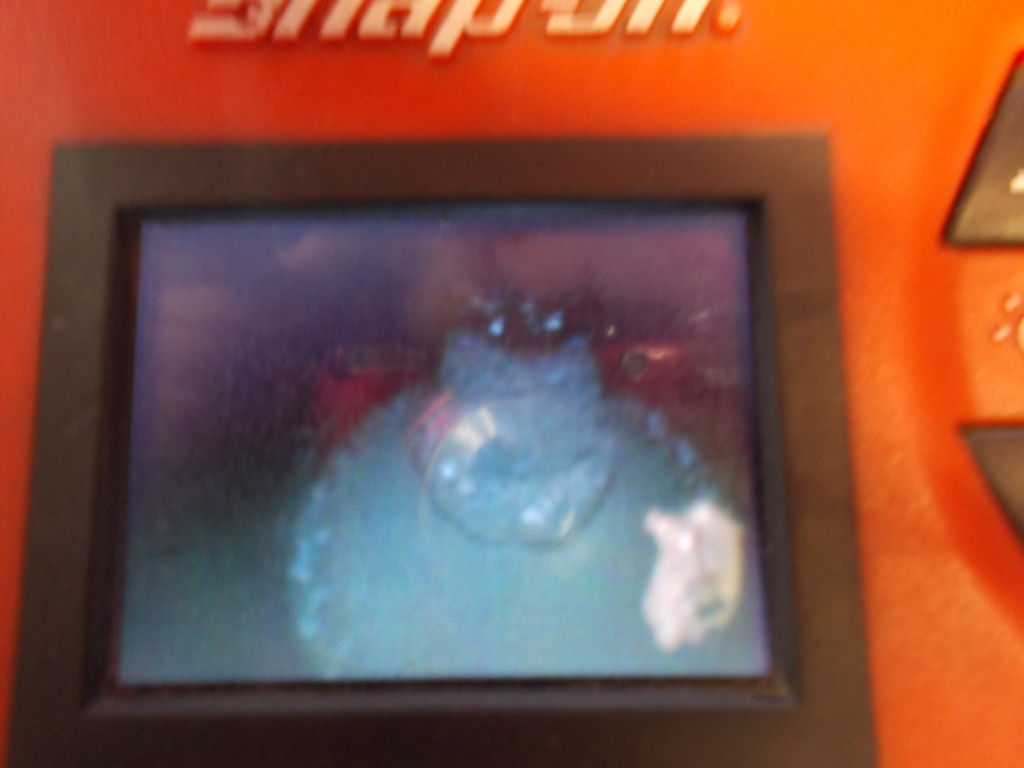
and same type engine with no system at 30k miles:
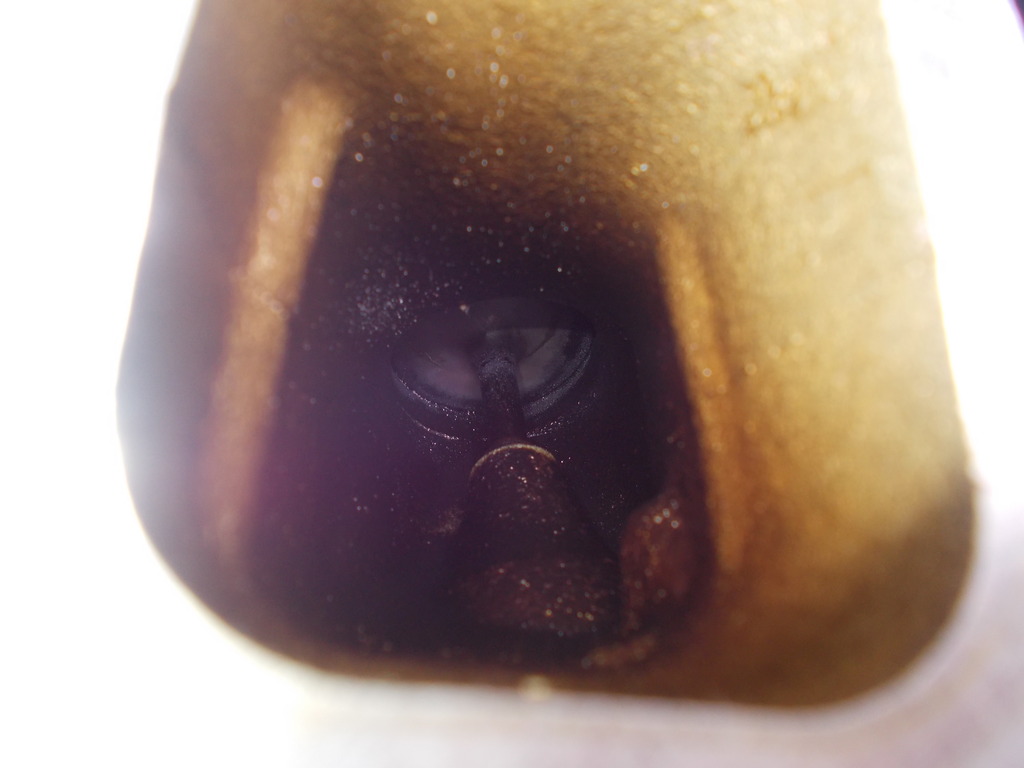
But, at 50k or 70k would be a better indicator, and we would also have to have control over what oil was used, etc. to be more accurate.
So we look at the experts in studying this:
Final results of 2 year study
"Here is a brief summary of what was documented in the 2 year testing by one of the Worlds largest Lubrication companies:
The XXX (brand not listed as it covers several that have licensed the design) system was tested on the most severe engine on the road toady as far as GDI related issues. The testing was performed on a fleet of new vehicles including GM and others, but they only focused on the results of the Ford Ecoboost engines as they experience the most severe GDI related effects.
First, here is how the testing was performed. Each vehicle has been run through proper break-in and driven over 10k miles to eliminate ring seating variance, etc.
Then the vehicle would be run for app 5-6k miles on their premium full synthetic oil and a sample drawn...this is without our system installed. Then, our system is installed on that same oil fill, no oil change, and then run another 4-5k miles and another sample drawn and at that time oil is drained and changed.
Here are some examples on just viscosity and fuel dilution:
Miles on vehicle: 55060 Ford 3.5L Ecoboost
Miles on oil when sample drawn: 5,943 Fuel dilution: 5.6% Viscosity @40*C: 45.71 Viscosity @100*C: 8.76 (Now, vehicle is driven and sample drawn below)
Miles on oil when sample drawn: 9,411 Fuel dilution: 3.86% Viscosity @40*C: 46.98 Viscosity @100*C: 8.82 (Even AFTER saturation well above the industry 5% threshold where oil is considered "condemned" or no longer able to protect the engine our system was able to not only prevent further fuel dilution and viscosity degradation, but actually IMPROVED each taking the oil that was no longer usable and extending it's ability to protect far longer.
Now, that was the least dramatic result....some were as high as fuel dilution levels of 7% to above 12% by 5k miles (cold start enrichment in cool/cold conditions adds to dilution far quicker) and we were able to bring those levels down even more dramatically, in some cases by as much as 50% less after a few thousand miles WITH our system installed.
Other benefits documented: Average fuel economy increases of 1-3 MPG due to a cleaner burn with the contaminants removed from the PCV vapors as more energy is released with just air and fuel present during the combustion process. This also shows a significant reduction in knock retard as pre-ignition is reduced and combined with a cleaner burn in the combustion chamber, reduces emissions as well as improves fuel economy.
As our system converts the PCV system to full time evacuation and flushing VS part time as the OEM systems come and retains a closed emissions compliant system.
This prevents the stagnant periods of operation when the contaminants and combustion by-products that enter as blow-by and are the primary source of oil contamination and our system greatly reduces this by removing these at all times the engine is running utilizing 2 separate evacuation suction sources, the intake manifold vacuum for when reversion pluses are not canceling it out (during acceleration or hard operation no evacuation suction is present stock), and using the Venturi effect when accelerating or running high RPM/throttle.
On GDI engines (most all Automakers are now 100% GDI) we have the additional benefit of reducing the intake valve coking issue by as much as 85% (we cannot eliminate all as these engines use variable valve events to allow back filling of exhaust gasses back into the port behind the valves to be re-burnt emulating the outdated EGR system/valves of old.
To summarize, the benefits:
Engine life extended to 2-3 times expected life w.out the system installed.
Fuel economy increase of 1-3 MPG average.
Extended oil drain intervals allowing from 50% to 100% longer use of oil reducing pollution from improperly disposed of drain oil.
Reduced tailpipe emissions. As we remove most of the compounds causing a incomplete burn in the combustion process reducing the amount of emissions.
Reduction of intake valve deposits by as much as 85%.
The downside is these MUST be drained and the contents collected disposed of properly as with any drain oil. every 5k miles as a rule (will vary from engine to engine depending on state of piston ring seal to cylinder walls).
We do have a system that never needs to be emptied or service for in excess of 100k miles, but not released yet that could be retrofitted at a later date.
What is in the contents of the system that are removed from the engine crankcase vapors?
Here is a sample after a 2400 mile drain after being spun in a centrifuge to separate all for analysis:
70% was acidic water (the sulfuric acid produced during the combustion process cannot be separated from the water).
23% was raw fuel (GDI engines introduce fuel at well over 2,000 PSI and this pushes many times the amount past the rings of old port injection systems that operated at 45-50%)
and only 7% was actual oil, and it is saturated with abrasive particulate matter.
This other wise would have remained in the crankcase mixing with and contaminating the engine oil, and also contaminating the intake air charge reducing the over efficiency of the engines combustion process.
On Fleet applications, depending on miles driven the fuel economy and oil drain extensions give a ROI in app 6.7 months average. As a whole, these could drastically reduce overall emissions as well as tremendous savings on fuel cost and usage."
Keep the discussion going. THIS is what this thread is for.

Last edited by COSPEED; 06-29-2017 at 03:33 PM.
#429
Melting Slicks


Thread Starter
And how the car was driven....driven easy we see more severe coking than those driven hard and aggressively. Figured I should add that as well.
#430
Do you have pictures of the valves stems with an GDI engine running your system after 10-20K miles to compare it to the GDI engines not running your system.
#431
I have a question because the pvc system is the cause of this because of GDI. Can you take the dirty side of the PVC system, dump it into a catch can and have the clean side just dump into the atmosphere or some kind of filter or another catch can and just don't send it back into the engine.
I don't live where there is emissions testing but even if you do, you can just hook it back up for the test, then disconnect to keep the the oil going back into the clean side. This of course does not consider the enviroment just the investment into our cars, until GM comes up with something. Would this work. Will it throw any codes?
I don't live where there is emissions testing but even if you do, you can just hook it back up for the test, then disconnect to keep the the oil going back into the clean side. This of course does not consider the enviroment just the investment into our cars, until GM comes up with something. Would this work. Will it throw any codes?
Last edited by mbaessler; 06-29-2017 at 06:40 PM.
#432
No one has run a catch can or one of the brands discussed here by COSPEED and opened up the head to see if it makes any difference on the valves. In theory it should work or help but we need pictures don't we?
#433
I have a question because the pvc system is the cause of this because of GDI. Can you take the dirty side of the PVC system, dump it into a catch can and have the clean side just dump into the atmosphere or some kind of filter or another catch can and just don't send it back into the engine.
I don't live where there is emissions testing but even if you do, you can just hook it back up for the test, then disconnect to keep the the oil going back into the clean side. This of course does not consider the enviroment just the investment into our cars, until GM comes up with something. Would this work. Will it throw any codes?
I don't live where there is emissions testing but even if you do, you can just hook it back up for the test, then disconnect to keep the the oil going back into the clean side. This of course does not consider the enviroment just the investment into our cars, until GM comes up with something. Would this work. Will it throw any codes?
#434
Melting Slicks


I have a question because the pvc system is the cause of this because of GDI. Can you take the dirty side of the PVC system, dump it into a catch can and have the clean side just dump into the atmosphere or some kind of filter or another catch can and just don't send it back into the engine.
I don't live where there is emissions testing but even if you do, you can just hook it back up for the test, then disconnect to keep the the oil going back into the clean side. This of course does not consider the enviroment just the investment into our cars, until GM comes up with something. Would this work. Will it throw any codes?
I don't live where there is emissions testing but even if you do, you can just hook it back up for the test, then disconnect to keep the the oil going back into the clean side. This of course does not consider the enviroment just the investment into our cars, until GM comes up with something. Would this work. Will it throw any codes?
#435
Melting Slicks


I'm no mechanic/tech ,so this is my question.
Does the V4 mode contribute to this problem any?
I drive mostly on interstates in Eco mode on long trips.
Just curious...
\db2
Does the V4 mode contribute to this problem any?
I drive mostly on interstates in Eco mode on long trips.
Just curious...
\db2
#436
If there are any technical/engineering folks out there would this work and protect our valves from coking until GM comes up with a solution that is backward comparable? This seems crazy! We probably wish we were still port injected. That would provide clean valves for the life of the engine. So I hope what I talked above is a solution, to keep the oil out.
Last edited by mbaessler; 07-01-2017 at 03:55 PM.
#437
Melting Slicks


Thread Starter
I have a question because the pvc system is the cause of this because of GDI. Can you take the dirty side of the PVC system, dump it into a catch can and have the clean side just dump into the atmosphere or some kind of filter or another catch can and just don't send it back into the engine.
I don't live where there is emissions testing but even if you do, you can just hook it back up for the test, then disconnect to keep the the oil going back into the clean side. This of course does not consider the enviroment just the investment into our cars, until GM comes up with something. Would this work. Will it throw any codes?
I don't live where there is emissions testing but even if you do, you can just hook it back up for the test, then disconnect to keep the the oil going back into the clean side. This of course does not consider the enviroment just the investment into our cars, until GM comes up with something. Would this work. Will it throw any codes?
20k miles on LT1 Stingray before and after cleaning:
(photobucket is down, but the pictures are in these threads)
Yes. Any valve overlap that allows burnt gasses to back fill behind the valves will.
Last edited by COSPEED; 07-01-2017 at 03:57 PM.
#438
First, it would be illegal in all 50 States, and your opening the system to the atmosphere. You always want clean fresh MAF metered air entering the cleanside (should never flow backwards...) with clean side air entering each valve cover, traveling past the rocker arms, down the pushrod valleys into the center of the crankcase where it flushes and makes up for the foul contaminant laden vapors being evacuated (sucked out) the valley PCV barb. Also, what is trapped in the foul/dirty side cannot be reintroduced to the crankcase as it is a concentration of damaging compounds and very little oil that is trapped and removed from the PCV vapors. The PCV system has many functions, and only one is pollution control related. Mainly it removes the compounds created during the combustion process that get pushed past the piston rings as blow-by. If these are allowed to settle and mix with the oil, most is there to stay. The PCV systems clean, or fresh side on the LT based engines enters both valve covers. On the LS it only enters the passenger side valve cover. The dirty/foul vapors must be evacuated (sucked out) the opposite bank or portion of the crankcase so it is clearing and removing them at a constant rate. Think of your crankcase as a room with a window on each end. There is a vent in the floor (the blow-by) that is always pouring in smoke. If you open one window, then some smoke will exit with the pressure equalizing, but most stays in the room (like most catchcan systems, especially breather or vented ones). Now open the opposite window and put a fan in constantly pulling the smoke out, and the fresh air coming in from the opposite and the room will quickly clear as will the smoke entering. That is what the Colorado Speed and Elite E2 and E2-X systems do if configured properly. If you use a can only using IM vacuum, and with a breather, your duplicating the first scenario and leaving most of the wear causing compounds in the crankcase.
Dozens...hundreds, thousands over the years, and yes, the difference is pretty dramatic. But as these variable valve timing engines allow for some back filling of burnt gasses to emulate the function of the old EGR systems, there is no way to prevent 100%. But average is app. 85% with these 95% effective designs. Remember, the average well known brands only trap from 15% to a maximum f 30% of what enters them with the rest still passing through and causing the issues.
Not likely. This started with the Euro and Japanese GDI engines and is well documented. BMW is really the only brand that has taken the steps of offering the crushed walnut shell media blasting under warranty. GM was replacing entire cylinder heads as was Ford, but for the most part the official stance is to hide this and keep it from the public. Prior to the LT engines being released, GM officially stated this was not an issue and had zero affect on its other GDI engines (but thousands of hits from Google searches show it is well documented. Google search " Direct Injection Intake valve Coking" and click on images). The GM came out and emphasized the improvements made to combat the intake valve coking issues they claimed were non existent prior. Having worked as an Automotive Engineer for over 4 decades, this is common practice. So don't expect anyone to address it under warranty, especially as they claim it does not exist.
20k miles on LT1 Stingray before and after cleaning:
(photobucket is down, but the pictures are in these threads)
Correct. The incoming air must be metered (measured) by the MAF sensor as it ultimately becomes part of the intake air charge. If not, short term fuel trims go nuts trying to adjust as the data form the IAT, MAF, MAP, and upstream O2 sensors does not fit into the acceptable and expected parameters.
Yes. Any valve overlap that allows burnt gasses to back fill behind the valves will.
Dozens...hundreds, thousands over the years, and yes, the difference is pretty dramatic. But as these variable valve timing engines allow for some back filling of burnt gasses to emulate the function of the old EGR systems, there is no way to prevent 100%. But average is app. 85% with these 95% effective designs. Remember, the average well known brands only trap from 15% to a maximum f 30% of what enters them with the rest still passing through and causing the issues.
Not likely. This started with the Euro and Japanese GDI engines and is well documented. BMW is really the only brand that has taken the steps of offering the crushed walnut shell media blasting under warranty. GM was replacing entire cylinder heads as was Ford, but for the most part the official stance is to hide this and keep it from the public. Prior to the LT engines being released, GM officially stated this was not an issue and had zero affect on its other GDI engines (but thousands of hits from Google searches show it is well documented. Google search " Direct Injection Intake valve Coking" and click on images). The GM came out and emphasized the improvements made to combat the intake valve coking issues they claimed were non existent prior. Having worked as an Automotive Engineer for over 4 decades, this is common practice. So don't expect anyone to address it under warranty, especially as they claim it does not exist.
20k miles on LT1 Stingray before and after cleaning:
(photobucket is down, but the pictures are in these threads)
Correct. The incoming air must be metered (measured) by the MAF sensor as it ultimately becomes part of the intake air charge. If not, short term fuel trims go nuts trying to adjust as the data form the IAT, MAF, MAP, and upstream O2 sensors does not fit into the acceptable and expected parameters.
Yes. Any valve overlap that allows burnt gasses to back fill behind the valves will.
#439
Melting Slicks


Thread Starter
If this would work, I would assume you seal off the clean side part of the intake on the engine that would be the normal return. So the excess oils from the dirty side would go into the catch can but no output or just a breather.
If there are any technical/engineering folks out there would this work and protect our valves from coking until GM comes up with a solution that is backward comparable? This seems crazy! We probably wish we were still port injected. That would provide clean valves for the life of the engine. So I hope what I talked above is a solution, to keep the oil out.
If there are any technical/engineering folks out there would this work and protect our valves from coking until GM comes up with a solution that is backward comparable? This seems crazy! We probably wish we were still port injected. That would provide clean valves for the life of the engine. So I hope what I talked above is a solution, to keep the oil out.

#440
To add to my first reply, port injection will never be back. Chrysler was the lone hold out and was paying the fees by hanging on to port injection. This was mandated and GDI is here to stay. Many old timers can remember back in the pre-port injection era when we ran carburetors. As intake valve coking was a serious issue back then, rarely did an engine go more than 30-40k miles before a valve job was needed. This involved new guides or a cheap "knurling" procedure so the vales were not slapping and wobbling around in the guides with the wear this caused. The Fed's mandated minimal amounts of detergent additives to help combat this, but it was still a part of owning a car/truck. Most traded before 30k miles. Every repair shop and mechanic did valve jobs. Then port fuel injection was introduced, and this completely disappeared for decades and techs were no longer trained on doing this. Now we have it back worse than ever. Of course the inconal valve material and brass alloy guides wear much better now days, but wear is again occurring. The biggest advancements have n]been in far more effective internal separation, but that also retains the abrasive contaminants as well increasing oil contamination. And then the addition of small port injectors back as a blended "hybrid" system, but that results in increased knock retard and timing pulled due to a combustible mixture again being present during the compression stroke. Millions are being spent searching for solutions that do not require the owner emptying and disposing of the true separators, but to date, nothing is really making a huge impact, and the downsides are pretty negative. Go back and read the lubrication lab study. Look at what occurs when the raw fuel and other compounds are left in the oil. A port injection engine left little to contaminate in comparison. In all my years in the industry, I have never seen anything affect the industry as a whole as GDI issues, and I lived through the Pinto, Vega, and more.


Here it is:
But do you have a picture of an LT1 engine with 15K or more miles that had one of your catch cans on it. That way we can see the reduction of coking compared to a non catch can protected engine. A picture would really show the effectiveness of your system, delaying the eventual valve cleaning. Doesn't that request make sense? Am I missing something here. Are there no examples of LT1 engines with and without a Catch can for coking comparisons? Isn't this a reasonable request. I'm about ready to buy a Vette and I'm having 2nd thoughts. I have a nice port injected Hemi Challenger right now. No valve issues. But I think the new Vettes are terrific!
Last edited by mbaessler; 07-01-2017 at 04:37 PM.



